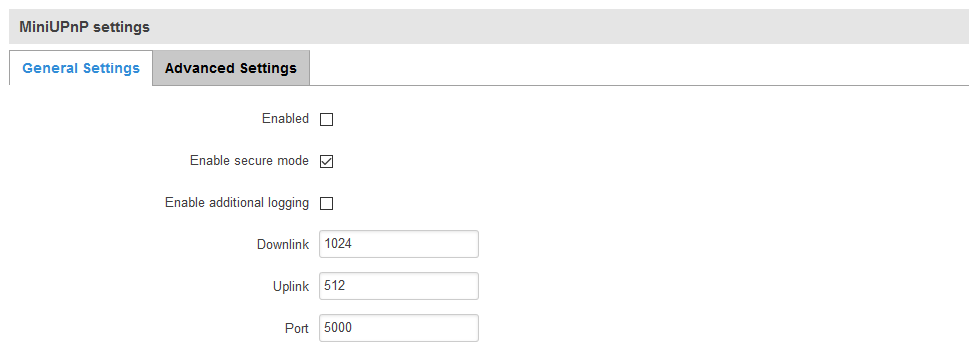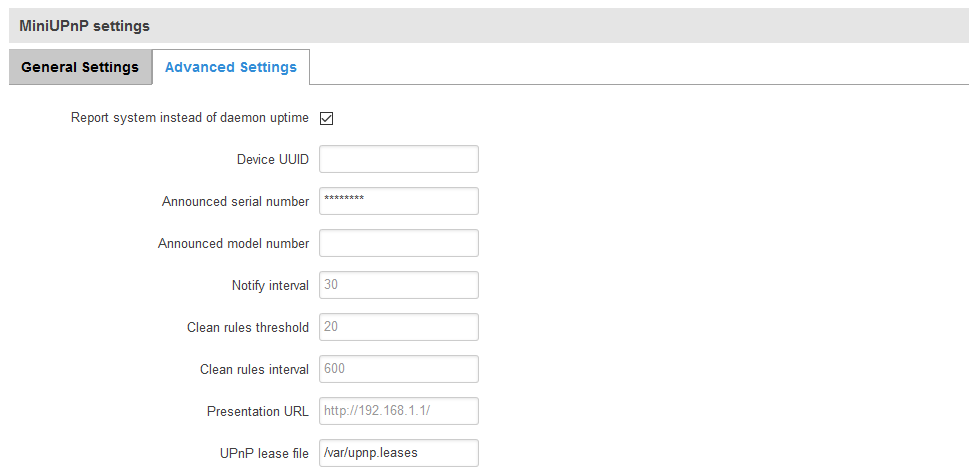Template:Networking rut manual upnp: Difference between revisions
No edit summary |
Gytispieze (talk | contribs) No edit summary |
||
| (7 intermediate revisions by 2 users not shown) | |||
| Line 1: | Line 1: | ||
{{Template: Networking_rutxxx_manual_fw_disclosure | {{Template: Networking_rutxxx_manual_fw_disclosure | ||
| fw_version = {{#switch: {{{series}}} | | fw_version = {{#switch: {{{series}}} | ||
| RUT2XX = {{{series}}}_R_00.01. | | RUT2XX = {{{series}}}_R_00.01.14.3 | ||
| RUT9XX = {{{series}}}_R_00.06. | | RUT9XX = {{{series}}}_R_00.06.08.2}} | ||
}} | }} | ||
==Summary== | ==Summary== | ||
{{Template: | <b>UPnP</b> (<b>Universal Plug and Play</b>) is a service that allows clients in the local network to automatically configure some devices and services. | ||
| | |||
| series | This chapter of the user manual provides an overview of the UPnP page in {{{name}}} devices. | ||
| | |||
{{Template: Networking_rutos_manual_package_disclosure | |||
| name = {{{name}}} | |||
| series = {{{series}}} | |||
| package = UPnP | |||
}} | }} | ||
==Active UPnP Redirects== | ==Active UPnP Redirects== | ||
| Line 26: | Line 28: | ||
<table class="nd-mantable"> | <table class="nd-mantable"> | ||
<tr> | <tr> | ||
<th>Field | <th>Field</th> | ||
<th>Value</th> | <th>Value</th> | ||
<th>Description</th> | <th>Description</th> | ||
| Line 32: | Line 34: | ||
<tr> | <tr> | ||
<td>Enabled</td> | <td>Enabled</td> | ||
<td>yes | no; | <td>yes | no; default: <b>no</b></td> | ||
<td>Toggles UPnP on or off.</td> | <td>Toggles UPnP on or off.</td> | ||
</tr> | </tr> | ||
<tr> | <tr> | ||
<td>Enable secure mode</td> | <td>Enable secure mode</td> | ||
<td>yes | no; | <td>yes | no; default: <b>yes</b></td> | ||
<td>Toggles secure mode on or off.</td> | <td>Toggles secure mode on or off.</td> | ||
</tr> | </tr> | ||
<tr> | <tr> | ||
<td>Enable additional logging</td> | <td>Enable additional logging</td> | ||
<td>yes | no; | <td>yes | no; default: <b>no</b></td> | ||
<td>Puts extra debugging information into the system log.</td> | <td>Puts extra debugging information into the system log.</td> | ||
</tr> | </tr> | ||
<tr> | <tr> | ||
<td>Downlink</td> | <td>Downlink</td> | ||
<td>integer; | <td>integer; default: <b>1024</b></td> | ||
<td>Bandwidth available for traffic coming in from the external interface in kbit/s. Note that this only information given to clients, it doesn't control the speed. In order to control the speed, you can try configuring [[{{{name}}}_QoS#QoS|QoS]].</td> | <td>Bandwidth available for traffic coming in from the external interface in kbit/s. Note that this only information given to clients, it doesn't control the speed. In order to control the speed, you can try configuring [[{{{name}}}_QoS#QoS|QoS]].</td> | ||
</tr> | </tr> | ||
<tr> | <tr> | ||
<td>Uplink</td> | <td>Uplink</td> | ||
<td>integer; | <td>integer; default: <b>512</b></td> | ||
<td>Bandwidth available for traffic out the external interface in kbit/s. Note that this only information given to clients, it doesn't control the speed. In order to control the speed, you can try configuring [[{{{name}}}_QoS#QoS|QoS]].</td> | <td>Bandwidth available for traffic out the external interface in kbit/s. Note that this only information given to clients, it doesn't control the speed. In order to control the speed, you can try configuring [[{{{name}}}_QoS#QoS|QoS]].</td> | ||
</tr> | </tr> | ||
<tr> | <tr> | ||
<td>Port</td> | <td>Port</td> | ||
<td>integer [1..65535]; | <td>integer [1..65535]; default: <b>5000</b></td> | ||
<td>Port to listen for requests.</td> | <td>Port to listen for requests.</td> | ||
</tr> | </tr> | ||
| Line 68: | Line 70: | ||
<table class="nd-mantable"> | <table class="nd-mantable"> | ||
<tr> | <tr> | ||
<th>Field | <th>Field</th> | ||
<th>Value</th> | <th>Value</th> | ||
<th>Description</th> | <th>Description</th> | ||
| Line 74: | Line 76: | ||
<tr> | <tr> | ||
<td>Report system instead of daemon uptime</td> | <td>Report system instead of daemon uptime</td> | ||
<td>yes | no; | <td>yes | no; default: <b>yes</b></td> | ||
<td>Use system uptime as UPnP uptime.</td> | <td>Use system uptime as UPnP uptime.</td> | ||
</tr> | </tr> | ||
<tr> | <tr> | ||
<td>Device UUID</td> | <td>Device UUID</td> | ||
<td>string; | <td>string; default: <b>unique</b></td> | ||
<td>The Device UUID attribute specifies and uniquely identifies a device that supports Universal Plug and Play (UPnP).</td> | <td>The Device UUID attribute specifies and uniquely identifies a device that supports Universal Plug and Play (UPnP).</td> | ||
</tr> | </tr> | ||
| Line 114: | Line 116: | ||
<tr> | <tr> | ||
<td>UPnP lease file</td> | <td>UPnP lease file</td> | ||
<td>string; | <td>string; default: <b>/var/upnp.leases</b></td> | ||
<td>Stores active UPnP redirects in a lease file (specified), like DHCP leases.</td> | <td>Stores active UPnP redirects in a lease file (specified), like DHCP leases.</td> | ||
</tr> | </tr> | ||
| Line 133: | Line 135: | ||
<tr> | <tr> | ||
<td>Comment</td> | <td>Comment</td> | ||
<td>string; | <td>string; default: <b>none</b></td> | ||
<td>Adds a comment to this rule.</td> | <td>Adds a comment to this rule.</td> | ||
</tr> | </tr> | ||
<tr> | <tr> | ||
<td>External ports</td> | <td>External ports</td> | ||
<td>integer [0..65535 | <td>integer [0..65535] | range of integers [0-65535]; default: <b>none</b></td> | ||
<td>External port(s) which may be redirected. May be specified as a single port or a range of ports. To specify a range use a dash ('-') symbol between two integer numbers.</td> | <td>External port(s) which may be redirected. May be specified as a single port or a range of ports. To specify a range use a dash ('-') symbol between two integer numbers.</td> | ||
</tr> | </tr> | ||
<tr> | <tr> | ||
<td>Internal Addresses</td> | <td>Internal Addresses</td> | ||
<td>ip/integer [0..32]; | <td>ip/integer [0..32]; default: <b>none</b></td> | ||
<td>Internal address to redirect to.</td> | <td>Internal address to redirect to.</td> | ||
</tr> | </tr> | ||
<tr> | <tr> | ||
<td>Internal ports</td> | <td>Internal ports</td> | ||
<td>integer [0..65535 | <td>integer [0..65535] | range of integers [0-655355]; default: <b>none</b></td> | ||
<td>Internal port(s) to redirect to May be specified as a single port or a range of ports. To specify a range use a dash ('-') symbol between two integer numbers.</td> | <td>Internal port(s) to redirect to May be specified as a single port or a range of ports. To specify a range use a dash ('-') symbol between two integer numbers.</td> | ||
</tr> | </tr> | ||
<tr> | <tr> | ||
<td>Action</td> | <td>Action</td> | ||
<td>allow | deny; | <td>allow | deny; default: <b>allow</b></td> | ||
<td>Allows or forbids the UPnP service to open the specified port.</td> | <td>Allows or forbids the UPnP service to open the specified port.</td> | ||
</tr> | </tr> | ||
Latest revision as of 13:43, 19 August 2021
The information in this page is updated in accordance with the [[Media:_WEBUI.bin|]] firmware version.
Summary
UPnP (Universal Plug and Play) is a service that allows clients in the local network to automatically configure some devices and services.
This chapter of the user manual provides an overview of the UPnP page in {{{name}}} devices.
UPnP is additional software that can be installed from the System → [[{{{name}}} Package Manager|Package Manager]] page.
Active UPnP Redirects
In this table you can see all currently active UPnP redirects.
General Settings
| Field | Value | Description |
|---|---|---|
| Enabled | yes | no; default: no | Toggles UPnP on or off. |
| Enable secure mode | yes | no; default: yes | Toggles secure mode on or off. |
| Enable additional logging | yes | no; default: no | Puts extra debugging information into the system log. |
| Downlink | integer; default: 1024 | Bandwidth available for traffic coming in from the external interface in kbit/s. Note that this only information given to clients, it doesn't control the speed. In order to control the speed, you can try configuring [[{{{name}}}_QoS#QoS|QoS]]. |
| Uplink | integer; default: 512 | Bandwidth available for traffic out the external interface in kbit/s. Note that this only information given to clients, it doesn't control the speed. In order to control the speed, you can try configuring [[{{{name}}}_QoS#QoS|QoS]]. |
| Port | integer [1..65535]; default: 5000 | Port to listen for requests. |
Advanced Settings
| Field | Value | Description |
|---|---|---|
| Report system instead of daemon uptime | yes | no; default: yes | Use system uptime as UPnP uptime. |
| Device UUID | string; default: unique | The Device UUID attribute specifies and uniquely identifies a device that supports Universal Plug and Play (UPnP). |
| Announced serial number | string; Default: none | Specifies serial number for XML Root Desc. |
| Announced model number | string; Default: none | Specifies model number for XML Root Desc. |
| Notify interval | integer; Default: none | Interval in which UPnP capable devices send a message to announce their services. |
| Clean ruler threshold | integer; Default: none | Minimum number of redirections before clearing rules table of old (active) redirections. |
| Clean ruler interval | integer; Default: none | Number of seconds before cleaning redirections. |
| Presentation URL | string; Default: none | Presentation url used for the Root Desc. |
| UPnP lease file | string; default: /var/upnp.leases | Stores active UPnP redirects in a lease file (specified), like DHCP leases. |
UPnP ACLs
ACLs specify which external ports may be redirected to which internal addresses and ports. There are two preconfigured rules, one to allow high ports, and another to deny the rest. Highest priority is at the top of a list and goes down. To add another specific rule press add button
| Field name | Value | Description |
|---|---|---|
| Comment | string; default: none | Adds a comment to this rule. |
| External ports | integer [0..65535] | range of integers [0-65535]; default: none | External port(s) which may be redirected. May be specified as a single port or a range of ports. To specify a range use a dash ('-') symbol between two integer numbers. |
| Internal Addresses | ip/integer [0..32]; default: none | Internal address to redirect to. |
| Internal ports | integer [0..65535] | range of integers [0-655355]; default: none | Internal port(s) to redirect to May be specified as a single port or a range of ports. To specify a range use a dash ('-') symbol between two integer numbers. |
| Action | allow | deny; default: allow | Allows or forbids the UPnP service to open the specified port. |
[[Category:{{{name}}} Services section]]




